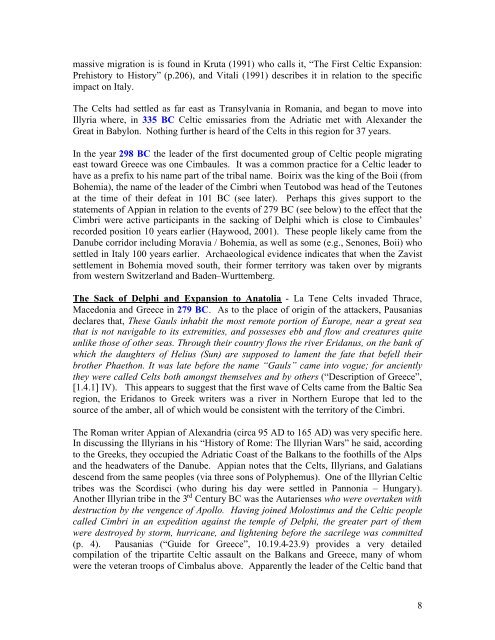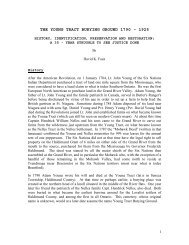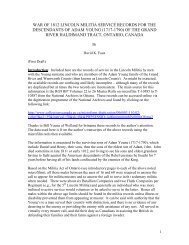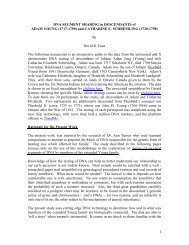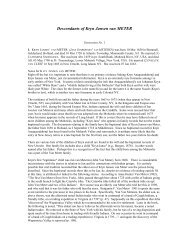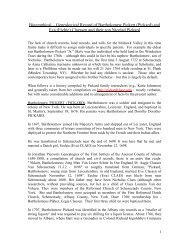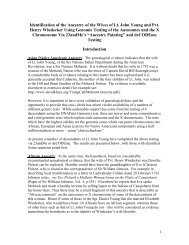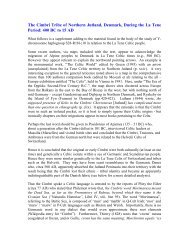Part 2 - Davidkfaux.org
Part 2 - Davidkfaux.org
Part 2 - Davidkfaux.org
Create successful ePaper yourself
Turn your PDF publications into a flip-book with our unique Google optimized e-Paper software.
massive migration is is found in Kruta (1991) who calls it, “The First Celtic Expansion:Prehistory to History” (p.206), and Vitali (1991) describes it in relation to the specificimpact on Italy.The Celts had settled as far east as Transylvania in Romania, and began to move intoIllyria where, in 335 BC Celtic emissaries from the Adriatic met with Alexander theGreat in Babylon. Nothing further is heard of the Celts in this region for 37 years.In the year 298 BC the leader of the first documented group of Celtic people migratingeast toward Greece was one Cimbaules. It was a common practice for a Celtic leader tohave as a prefix to his name part of the tribal name. Boirix was the king of the Boii (fromBohemia), the name of the leader of the Cimbri when Teutobod was head of the Teutonesat the time of their defeat in 101 BC (see later). Perhaps this gives support to thestatements of Appian in relation to the events of 279 BC (see below) to the effect that theCimbri were active participants in the sacking of Delphi which is close to Cimbaules’recorded position 10 years earlier (Haywood, 2001). These people likely came from theDanube corridor including Moravia / Bohemia, as well as some (e.g., Senones, Boii) whosettled in Italy 100 years earlier. Archaeological evidence indicates that when the Zavistsettlement in Bohemia moved south, their former territory was taken over by migrantsfrom western Switzerland and Baden–Wurttemberg.The Sack of Delphi and Expansion to Anatolia - La Tene Celts invaded Thrace,Macedonia and Greece in 279 BC. As to the place of origin of the attackers, Pausaniasdeclares that, These Gauls inhabit the most remote portion of Europe, near a great seathat is not navigable to its extremities, and possesses ebb and flow and creatures quiteunlike those of other seas. Through their country flows the river Eridanus, on the bank ofwhich the daughters of Helius (Sun) are supposed to lament the fate that befell theirbrother Phaethon. It was late before the name “Gauls” came into vogue; for ancientlythey were called Celts both amongst themselves and by others (“Description of Greece”,[1.4.1] IV). This appears to suggest that the first wave of Celts came from the Baltic Searegion, the Eridanos to Greek writers was a river in Northern Europe that led to thesource of the amber, all of which would be consistent with the territory of the Cimbri.The Roman writer Appian of Alexandria (circa 95 AD to 165 AD) was very specific here.In discussing the Illyrians in his “History of Rome: The Illyrian Wars” he said, accordingto the Greeks, they occupied the Adriatic Coast of the Balkans to the foothills of the Alpsand the headwaters of the Danube. Appian notes that the Celts, Illyrians, and Galatiansdescend from the same peoples (via three sons of Polyphemus). One of the Illyrian Celtictribes was the Scordisci (who during his day were settled in Pannonia – Hungary).Another Illyrian tribe in the 3 rd Century BC was the Autarienses who were overtaken withdestruction by the vengence of Apollo. Having joined Molostimus and the Celtic peoplecalled Cimbri in an expedition against the temple of Delphi, the greater part of themwere destroyed by storm, hurricane, and lightening before the sacrilege was committed(p. 4). Pausanias (“Guide for Greece”, 10.19.4-23.9) provides a very detailedcompilation of the tripartite Celtic assault on the Balkans and Greece, many of whomwere the veteran troops of Cimbalus above. Apparently the leader of the Celtic band that8


